|
|
|
Mauritius - Weather and Climate
Those who spend their holidays in Mauritius know that they are exposed to a hot and tropical area. And those who have a look on the world map or on the globus will recognize immediately that Mauritius is located in the southern hemisphere; this means that there is summer in the island when it is winter in our country and of course the way around. Thus, the circumstances are displaced by six months. But there is more that should be known about the climate of the island than the fact that the summer and the winter time are swapped in our latitudes. This is why in the following I will mention some basic events concerning the weather and the climate of Mauritius. Tropical Climate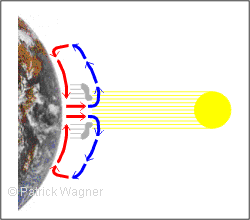
Mauritius is approximately located at the 20th southern latitude, thus within the tropical belt between the northern and the southern tropic at 22.5° each. As a comparison: Munich is situated at approximately 48° northern latitude. Between both tropics, the sun is located vertically in the sky, depending on the season. As known, on June 21st of each year, the sun is vertically positioned at the northern tropic; this is the longest day in our latitudes, then we celebrate midsummer festival in germany. On September 21st, the sun is positioned right at the equator vertically, and on December 21st it is positioned over the southern tropic in the zenith. As Mauritius is situated a little upside the southern tropic, within a short time period, the sun is two times consecutively vertically positioned at the sky, approximately at the beginning of December and in the beginning of January. A vertical position of the sun means an extremly heat radiation to the climate. A lot of water evaporates and a lot of hot air transporting a lot of humidity ascends to the sky. In colder areas outside the vertical sun radiation, the air releases the containing water vapor and it rains. Accordingly, a storng heat combined with rainfalls and a high air humidity is characteristic for the tropical climate. South-East Trade Wind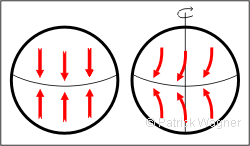
As just described, the sun is permanently positioned somewhere close to the equator vertically in the sky and effects an extreme heating of the country underneath. The consequence is a highly ascending hot air current that on the other hand entails a cold air current at ground level. This colder air current is absorbed either form the northern as also from the southern direction. As a result of the earth's rotation, these air currents drift westwards, so that at ground level, a wind from north-eastern and/or south-eastern direction results. These winds are demoninated as the north-east trade winds at the north and/or south-east trade winds at the south. More information concerning the trade winds is available on an extra page about the climate in the Canarian Islands. What effect do the south-east trade winds have on the climate of Mauritius? There is a light breeze from south-eastern direction the whole year through. Of course, this wind is obvious in the south-east of the island, while the north-west situated behind the mountains is protected against the wind. But as a vacationer and as a local person one does not only notice the wind but also its effect on the climate: clowds often accumulate at the mountainsides in the south east of the island, slowly ascend and thereby release their saved humidity in form of rainfalls. This is why in the south-west of the island, there are far more rainfalls as in the north-eastern part of the island. Thus, it is no wonder that in the north-western part of the island the majority of the tourists are seaside vacationers, while in the south-eastern part of the island there are rather wind and kite surfers. CyclonesWhile the south-east trade wind blows the whole year through and actually is a harmless and even pleasant event, in case of the cyclones the situation gets serious. They are also winds that are originated by the strong sun radiation, but they are tremendously more fiercely and destructive. Cyclones are originated during the months January up to March, when the sun is already returning from the southern tropic in direction to the northern tropic; While the sun is positioned for a short time vertically in the sky above the equator, thus only passes it briefly, it spends more time in the area of the tropics, as the sun gets there, turns around and slowly returns . The consequence is that the air and water temperatures strongly increase. As already described above, the strong temperatures mean a massive ascend of hot air into bigger highs. If this ascend exceeds a certain velocity and transports a lot of energy respectively, the ascending air can, as a consequence of the earth's rotation, start to rotate too and a massive cyclone with an extremely strong absorption upwards can be generated. Such a cyclone, also known by the name hurricane, tornado or taifun, is described in the Indian Ocean as a cyclone. If such a cyclone approaches the island, one should immediately look for a shelter. The rural inhabitants that live in some instable huts, search for shelter in public office buildings or churches. Hotels have to bring into safety everything what is not cast-iron. On the sea, metres-high waves are formed, torrential rainfalls descend on the island, the wind takes the roofs and the trees with it. The spectacle only takes a few hours, then the weather calms down again and the extent of the destruction gets visible. There are only extremely destructions if the cyclone straight passes over the island, thus with its eye. But also when a cyclone passes Mauritius at a distance of a few hundred kilometres, the consequences are noticable on the island: there are stronger rainfalls than usual, the wind blows fiercely and the sea breaks some massive waves against the coral reefs and/or the edge of the island. Weather and Climate Data of MauritiusThe following graphics give a general overview of the climate of the island Mauritius. It is immediately recognizable that the seasons are not so clearly pronounced on this island as in our latitudes. It is a tropical and maritime climate and not a continental climate. This is why the differences between summer and winter time are only slight. I also would like to mention straight in advance that these values are of statistical nature, thus equivalent to the average values over the decades. Thus, for example, if January is supposed to contain 6 rainy days, in one year they could be easily ten days and 2 in the next year. 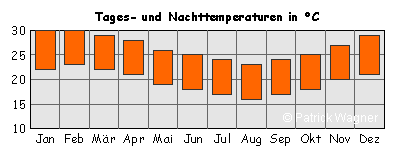 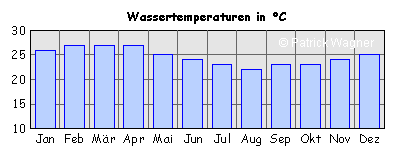 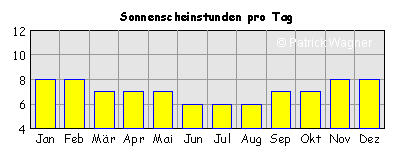 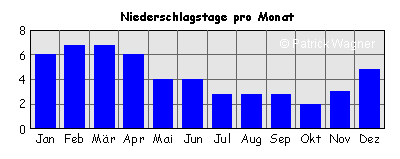 By looking at the day and night temperatures, we quick recognize that over the whole year it is pleasantly warm and actually not too hot; Even during the winter months June - September there is an average temperature of more than 20°C; Also by having a look to the graphic with the water temperatures one is delighted, as with a minimum of 22°C, one can bath in the pleasantly warm sea during the whole year. So far, nothing special for a holiday country. But the graph of the sun shine hours per day make also rapidly clear that we are in a tropical area, as, depending on the season, the sun only delights us for 6-8 hours per day. As a matter of fact, the daylight clearly persists longer time, in the summer(January) approximately from 6:00 a.m. up to 07:00 p.m. and in the winter (July) approximately from 7:00 a.m. up to 06:00 a.m. But these long summer evenings the way we know them where one can sit outdoors at crepuscular light up to 10:00 p.m. do not exist in Mauritius. Also if we have a look at the rainfall table we recognize that we are in a tropical area. It is not the case as in some other countries, there are no rainfalls at all during the summer months December, January, February; it rather rains clearly more in the summer months than in the winter months. This is related to the fact that in the summer, much more water evporates and comes down again. I can only reconfirm that to a holiday in Mauritius, one should in any case pack a jumper and an umbrella into the suitcase. Concerning the rainfall days there is to mention in addition that it does not rain huge amounts of water and that the most showers occur at night and that a small rain shower during a hot day does not mean at all that the temperatures will fall, as we typically experience it in our home country, but can be rather be a welcomed small refreshment. Also, I would like to reconfirm that by choosing the hotel there is to consider if the hotel has air-conditioned rooms. As even if the temperatures are still pleasant, the high air humidity can cause one some trouble at nights. Finally I would like to reconfirm the regional differences between the north-west and the south-east, as I already described above. The north-west is warmer and with less rainfalls as the south-east. Moreover, in the south-east there are stronger winds than in the north-west. 
Copyright: Patrick Wagner, www.tourist-guide.biz |
||